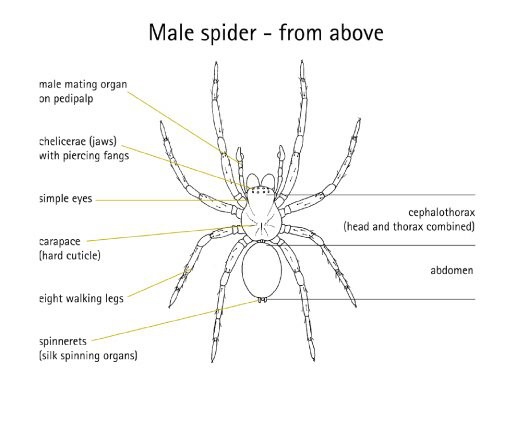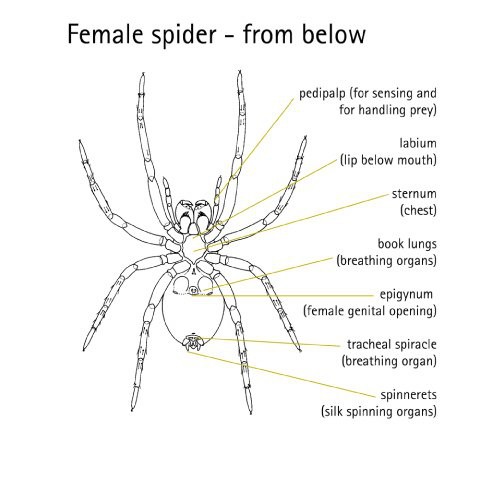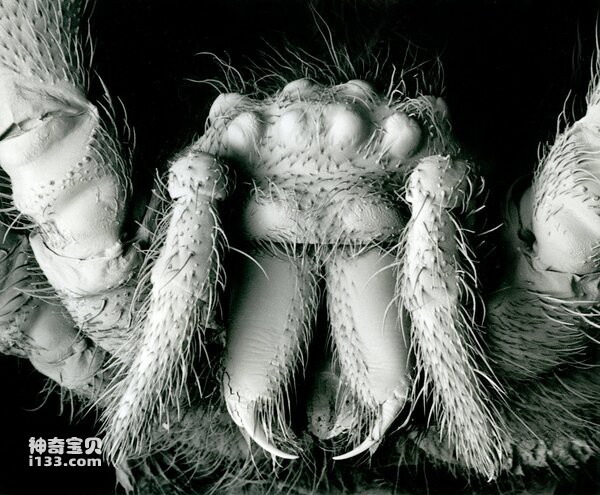Spiders are ancient animals, dating back millions of years. They have always been with us, ancient sources of fear and fascination. They are abundant and widespread and are natural controllers of insect populations.
Spiders are arachnids rather than insects, but both spiders and insects belong to the largest group of animals on Earth - the arthropods (ancient Greek: arthro = jointed, podos = feet) - which have a hard exoskeleton and An animal with jointed limbs.
Spiders are:
The two main parts of the body, the head and thorax are together called the cephalothorax and abdomen
eight walking legs
Simple eyes; spiders usually have eight eyes (some have six or fewer), but few have good eyesight.
Jaws adapted for tearing or piercing prey
a pair of tentacles
Abdominal silk-spinning organ
Anterior abdominal genital opening.


The spider's body is divided into two parts. The head and thorax, with eyes, mouthparts and legs, fuse together to form the cephalothorax. It is connected by a slender waist (pedicel) to a second body part, the abdomen, which contains the silk-spinning organs (spinnerets), genital pores, and respiratory organs (book lungs and/or trachea).
The top of the cephalothorax is covered with a hard, horny plate called a carapace - much like the hard "shell" of a crab.
On the outside of the cephalothorax
Simple eyes - usually eight (sometimes six), usually arranged in two rows along the front of the carapace (although the arrangement and size of the eyes vary).
Fovea - A depression in the middle of the carapace that is the internal attachment point for the pectoral muscles.
Mouthparts - two large jaws (chelicerae) with sharp canines, while on the underside behind the lower jaw there are two small horny plates (flattened pieces of cuticle) - an upper plate, the labrum (upper lip), Hidden in the lower labial plate (lower lip), clearly visible from behind the lower jaw. These two plates form the top and bottom of the tubular mouth, which opens behind the jaws. A pair of plate-like maxillary bones flank the lower lip, each with a row or block of food-cutting teeth at the front.
Palpable limbs - help with food processing, touch and taste, and in male spiders, the palpable limbs are modified into mating organs.
Legs - Four pairs of jointed legs with two to three terminal claws. Two-clawed spiders are hunters (e.g. jumping spiders, huntsman spiders, ground spiders) and most legs end in thick brushes (scythes or claw tufts) - these improve traction on smooth or sloping surfaces such as leaves or tree trunks . Many three-clawed spiders are web-builders, often with claws and hairs modified to handle silk (e.g., orb-weavers, glue-footed spiders, lace spiders).
The inside of the cephalothorax has
Muscles - help move the jaw and limbs. Muscles from the limbs, intestines, and carapace appendages are all connected to the central endosternum (internal non-chitinous skeletal plate).
Cerebral ganglia - masses of nervous tissue.
Venom glands - produce venom to kill prey
The muscular stomach - pumps liquid food into the esophagus (food tube) and pharynx (throat) and along the intestines. The end of the foregut forms the stomach. Diverticula (growths) that extend into the legs are also present in the cephalothorax.
The abdomen is usually covered with a thinner or more flexible cuticle - this allows expansion during feeding or egg development. The thin girdle or peduncle that separates it from the cephalothorax allows the abdomen to move, such as during silk spinning and mating displays.
On the outside of the abdomen
Book lung cover - protects the fragile organs inside
Genital pore or genital opening - from which eggs or sperm are released, located in the genital groove between the preceding pair of book lungs. Most female spiders have another separate, patchy opening for mating, the ectogyne.
Spinnerets (silk-spinning organs) - usually four or six, and the terminal anal tubercle, where the intestine ends.
On the inside of the abdomen
Lungs in this book - the respiratory organs. Small openings called stomata lead into air-filled cavities into which the thin, leaf-like lamellae of the book lungs extend, like rows of pages. The outer surface through which air passes is covered with a very thin layer of cuticle, from which spike-like struts extend to prevent the sheet from collapsing. Blood (hemelymph) circulates within the lamellae, and gas exchange between blood and air occurs on the thin walls of the lamellae. Mygalomorph (and some araneomorph) spiders have two pairs of book lungs. Most arachnids have only the front pair of book lungs, with the latter pair replaced by tiny epidermal tracheae that separate within the body to allow for more efficient gas exchange. Some tiny spiders that live in moist, sheltered habitats have no respiratory organs, and gas exchange occurs directly through the thin cuticle of the body.
Silk glands - produce the liquid proteins that make silk
Reproductive organs (ovaries or testicles).
Heart - Located in the midline of the body, it can be seen beating through the cuticles of the back. The blood circulation is open, that is, the blood vessels lead from the heart to the body space, bathing the tissues and organs in blood, and then gradually circulates back to the heart.
Hindgut and its diverticula - where nutrients are absorbed into the tissues. The hindgut has a sac into which an excretory organ called the Malfigian tubule (the spider's "kidney") opens.

In mygalomorph spiders (trapdoor and funnel-web spiders), the base of the large jaw projects forward and folds back underneath alongside their fangs. To bite their prey, these spiders must lift the front of their bodies, allowing their fangs to open like a pair of daggers and strike downward. In the more common arachnids (redbacks, wolf spiders, etc.), the lower jaw hangs vertically below the front of the carapace. The fangs are hinged laterally and interlock with each other like pincers. This is a more efficient way to capture and manipulate prey, especially online.
Like other arthropods, spiders' bodies are covered with a more or less hard "skin" or cuticle (exoskeleton), made of protein and chitin. Spider cuticles are made up of several layers, with the outermost layer being the hardest and covered with a thin layer of wax that helps reduce the loss of water in the body. The stratum corneum provides internal attachment points for muscles and helps regulate blood pressure. Despite its hard and protective exterior, the cuticle must still house the spider's sensory organs - in the form of various types of innervated (provided by nerves) hairs and pits, as well as eyes. The cuticle even extends inward, covering the foregut (mouth to stomach) and hindgut, the tracheal (breathing) tube, and the female's sperm storage organ (spermatocyst).
In order for a spider to grow, the entire cuticle must be shed periodically, a process called molting. First a new, larger cuticle grows under the old cuticle, the old cuticle splits and the spider crawls out. The new cuticle is very soft and most spiders will not move until the cuticle hardens.
The spider's exoskeleton surrounds a body space filled with blood. Within this semi-rigid space, blood pressure can change through changes in heart rate or the contraction and relaxation of muscles, especially the strong chest muscles. The cuticle and blood together form a pressurized unit called the hydrostatic skeleton. This is important to maintain body shape (bulge) and function.
The ability to change blood pressure is important for a variety of functions, including moulting and locomotion. During moulting, an increased heart rate causes an increase in blood pressure, which helps to open the delicate cuticle. The extension of the limbs during exercise is mainly achieved through the contraction of the strong chest muscles. The contraction of the chest muscles increases the blood pressure of the thorax, causing the limbs to stretch outward. This explains why spiders have many flexor muscles for bending their limbs inward, but fewer extensor muscles for extending their limbs outward—they just don't need as many. This also explains why the legs of injured or dead spiders always bend inwards - they can no longer control blood pressure, which allows powerful flexion muscles to take over and pull the legs under the body. This "death pose" is mimicked by spiders who escape predators by falling from their webs to the ground - only this time, their legs are deliberately bent as they play dead.
animal tags: spider
We created this article in conjunction with AI technology, then made sure it was fact-checked and edited by a Animals Top editor.